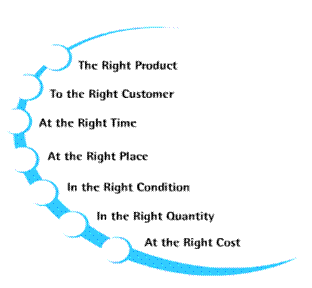What Is the Goal
of the Supply Chain?
Part 2 – Fortifying the Goal
 What is the goal of the supply chain? Based on part one of our discussion, we should agree that the classical goal and definition are insufficient to serve the prime directive of an enterprise, to make more money now and in the future.
What is the goal of the supply chain? Based on part one of our discussion, we should agree that the classical goal and definition are insufficient to serve the prime directive of an enterprise, to make more money now and in the future.
Today we fortify the goal and definition to make it sufficient.
First, what does it mean to fortify?
fortify |'fôrt?fi|
verb ( -fies, -fied) [ trans. ]
1) strengthen (a place) with defensive works so as to protect it against attack : the whole town was heavily fortified | [as adj. ] ( fortified) a fortified manor house.
2) strengthen or invigorate (someone) mentally or physically : I was fortified by the knowledge that I was in a sympathetic house.
While the goal and definition are insufficient, I believe that they are a good starting point. I suspect that other supply chain practitioners agree that the classical definition was insufficient, since there is ample evidence of attempts to fortify the definition.
Before we start to rework the definition on our own, let’s go see if someone has already solved the problem for us. The research may help us to avoid re-inventing the wheel. A sufficient goal and definition may exist.
Feeble Attempts to Fortify
Google the title of this article and a plethora of examples appears—attempts by different authors and supply chain software companies to redefine (or fortify) the classic definition of the goal of supply chain management.
These examples include bullet-point lists of the interested parties:
- suppliers
- production facilities
- distribution centers
- transportation providers
- customers
 Other examples of goals include discussions about the five rights. No, make it six rights. Oh darn, six is not enough, we must have seven rights of supply chain management. Some even say that there are ten points, twelve steps, and seven habits that concern supply chain management!
Other examples of goals include discussions about the five rights. No, make it six rights. Oh darn, six is not enough, we must have seven rights of supply chain management. Some even say that there are ten points, twelve steps, and seven habits that concern supply chain management!
There are many white papers and educational websites that, in different ways, present the idea that the ultimate goal of any effective supply chain management system is to optimize and maximize. They claim that you must optimize the deployment of assets to maximize fulfillment of demand (or customer service). Some claim that the objective is to achieve balance. A balance of what? They are unclear what you should balance! Optimization is a compromise of multiple conflicts. What does “maximize fulfillment of demand” mean?
There are vague attempts to tie cash as an asset, so there are mentions of inventory optimization, but no mention of how the deployment of inventory optimization or fulfillment demand generates cash!
Another speaks to the theory that when more assets are available within a supply chain, more assets are "ready" to fulfill demand, suggesting that we should have piles of assets at the ready because of the lack of coordination in the supply chain. Another goal focuses on the need to root out the causes of inefficiency and imbalance between asset buffers at each process step in the chain!
We can find quotations from preeminent authorities on the subject. Here is a sample from Penn State's Department of Management Science and Information Systems:
"Inventories exist at every stage of the supply chain as either raw materials, semi-finished or finished goods. They can also be in-process between locations. Their primary purpose is to buffer against any uncertainty that might exist in the supply chain. Since holding of inventories can cost anywhere between 20 percent to 40 percent of their value, their efficient management is critical in supply chain operations.”
Kicking off with inventories, a working capital asset class, this thought highlights that supply chain management is critical. But so far it only brushes up against the prime directive, failing to make the connection.
“It is strategic in the sense that top management sets goals. However, most researchers have approached the management of inventory from an operational perspective. These include deployment strategies (push versus pull), control policies— the determination of the optimal levels of order quantities and reorder points, and setting safety stock levels, at each stocking location. These levels are critical since they are primary determinants of customer service levels."
What Don’t I See?
 Yes, it is strategic that top management sets the goals, and the best minds approach supply chain management as a set of deployment strategies and policies to control operations. What we see is a tactical approach focused on order quantities, reorder points, and stocking levels, with a primary focus on customer service. There is no clear explanation of how better customer service results in making more money, now and in the future! Making money is an assumption!
Yes, it is strategic that top management sets the goals, and the best minds approach supply chain management as a set of deployment strategies and policies to control operations. What we see is a tactical approach focused on order quantities, reorder points, and stocking levels, with a primary focus on customer service. There is no clear explanation of how better customer service results in making more money, now and in the future! Making money is an assumption!
The deeper we dig into the research, the more we find articles that dive right into the tactical tasks and steps. Almost all of the discussion leaves the goal of supply chain management unspoken, as if the goal were so obvious that it didn’t even need to be stated!
This is where a really well-defined goal is missing. Where is our mission, our purpose?
A Mission Looking for Clear Purpose
What I don’t see in much of our research is a clear connection showing how the tactical activities support the prime directive. If an article makes the connection, the goal is to deploy tactics that focus on the loose change found in the cushions of the logistics couch. The tactics present cost-reduction schemes that reduce costs by 5–10 percent, or even as much as 15 percent.
These cost-reductions are insufficient to noticeably improve Operating Cash Flow. In some cases, the effort to secure incremental cost reductions actually erodes OCF.
Let’s look at that devastating statement again. This is the CFO’s point of resistance when supply chain managers come looking for more investment cash for the next new system or process. The typical CFO expects the supply chain manager to find 10–15 percent cost reduction every year just to maintain profitability, defending profitability through cost controls! Every CFO has bitter memories of unfulfilled expectations. In some lucky cases, the improvements merely offset the cost increases in other areas of the supply chain. Seasoned CFOs are skeptical of cost reduction claims because in their experience the savings claims failed to produce positive operating cash. They saw declines in operating cash, and no clear answers to the question “Why?”
I know first hand that this is true, as I worked with different CFOs who demanded constant cost reductions. What got the positive attention of these CFOs was a discussion about how to multiply Operating Cash Flow.
Meeting of the Minds
Cost reduction gains are insufficient to drive noticeable change in Operating Cash Flow. In many cases, the effort to secure incremental cost reductions actually erodes OCF.
This statement raises fundamental questions for the CFO and the supply chain manager.
- What kind of cost reduction is sufficient to drive change in Operating Cash Flow?
- How can cost reduction erode Operating Cash Flow?
When the Supply Chain Manager asks the CFO these questions, he takes the first steps toward clarifying the strategic goals of the enterprise. When the CFO makes the first effort to answer these questions for the supply chain manager, the journey toward goal alignment begins. It is the discussion and resulting discovery by both the supply chain manager and the CFO that aligns the goals with the prime directive. In this journey of discovery, the supply chain manager and the CFO learn that massive improvement comes from actions that change both the balance sheet and the income statement.
Looking through the lens of Management by Objectives, the effort to learn breathes new life into the directive to “reduce organizational inefficiencies.” This changes the language of the goal to reflect what the managers do when they address these fundamental questions: create knowledge. Perhaps our goal should be to “improve organizational knowledge and efficiency.” Much more positive, the change is building a better company. This helps fortify our goal, but we are not yet done.
Our goal is still insufficient.
Effective vs. Efficient
What does it mean to be efficient? What does it mean to be effective? Does one require the other? Does one guarantee the other? What is the difference?
We must examine that difference, thinking of which to include in our goal.
effective |i'fektiv| adjective
1. Successful in producing a desired or intended result: effective solutions to environmental problems.
2. Adequate to accomplish a purpose; producing the intended or expected result.
efficient |i'fi sh ?nt| adjective
1. Achieving maximum productivity with minimum wasted effort or expense.
2. Working in a well-organized and competent way.
Consider our prime directive; make more money, now and in the future. Do we accomplish our prime directive merely by being efficient, or must we be effective too? Can we become effective without being efficient?
Must we be efficient to become effective? Not necessarily. One way for us to make more money is to charge more for our product or service. Increasing the revenue per unit could increase our overall revenue. Increasing revenue does not change our efficiency or change our productivity. Charging more does increase our effectiveness in generating more money now and in the future. By charging more we make more money, producing the desired outcome.
Can we have an efficient supply chain and not be effective? The CFO’s argument above says yes, that can happen. Take the example of the many companies that invested in high-end WMS systems with the expectation of swift payoff in the form of labor reductions. Many companies caught financial influenza from these systems; they did gain productivity in some areas of labor, but they had to employ people to maintain system integrity—often creating more payroll than saved. Yes, productivity on the floor improved, but the headcounts did not drop sufficiently to offset the investment. There are so many examples of this that experienced CFOs tend to doubt savings claims made by software manufacturers.
Efficiency is insufficient for our goal. We want an effective supply chain. Yes, it needs to be as efficient as possible, but first it needs to be effective! Therefore, our goal should read “improve organizational knowledge and effectiveness.”
What Is Our Purpose?
Our goal is not complete. Remembering what Peter Drucker taught us, all goals should direct us to the primary goal of the company, in this case our prime directive; make more money, now, as well as in the future. We must not leave that out of the goal! So we need to include being profitable, right? So we need a line about making profits and improving earnings.
Well, not profits and earnings. We must focus on cash generation. Profit and earnings are abstract theories that you cannot take to the bank and deposit. We must look at the cash the supply chain generates. Not just any cash; we must focus on the operating cash flow the company generates.
Positive operating cash flow looks at more than profit, it considers the effect of the cash-to-cash cycle. The art of discount retail is not as much the profit margin, but the speed and frequency of the cash cycle—how much time it takes to recycle the cash and how many times it turns over. Operating cash flow takes into heavy consideration the value of the working capital trapped in inventory and receivables, and the velocity of cash through the financial segments of the supply chain. Success is a reflection of effective cash handling in the network. We must be clear in our goal that we are going to grow cash, specifically operating cash.
“The goal of supply chain management is to improve organizational knowledge and effectiveness to increase the operating cash generated, now and in the future.”
This is a much stronger goal, don’t you think? Is it sufficient yet?


